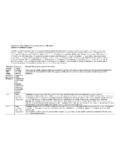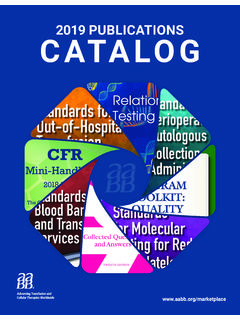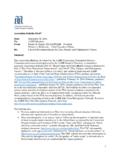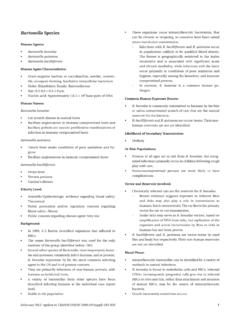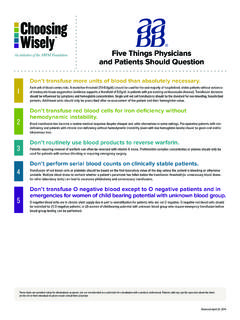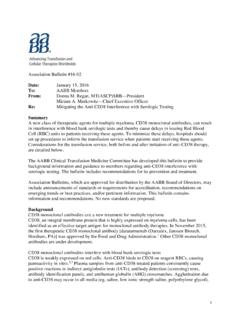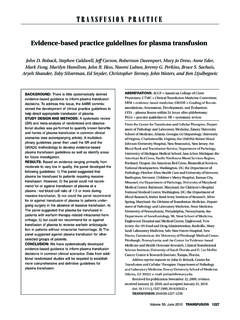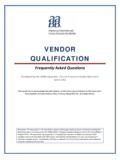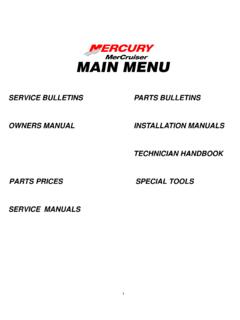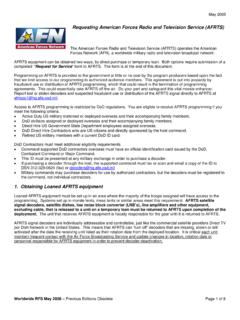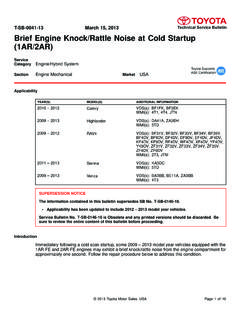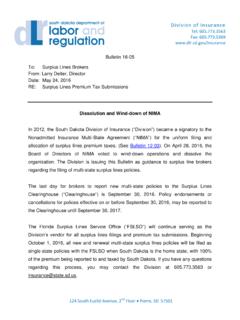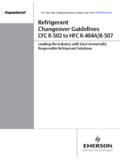Transcription of Date: To: AABB Members Graham Sher, MD, PhD
1 1 Association bulletin #14-02 Date: January 29, 2014 To: aabb Members From: Graham Sher, MD, PhD President Miriam A. Markowitz Chief Executive Officer Re: TRALI Risk Mitigation for Plasma and Whole Blood for Allogeneic Transfusion Summary The aabb Board of Directors has approved recommendations to meet aabb Standard , published in the 29th edition of Standards for Blood Banks and Transfusion Services (BBTS Standards). These recommendations were prepared by Members of the Blood Bank/Transfusion Service Standards Program Unit, the aabb Transfusion-Related Acute Lung Injury (TRALI) Task Force, and the work group responsible for aabb s July 2013 conference on TRALI risk reduction.
2 The recommendations have also been reviewed and approved by the Blood Bank/Transfusion Service Standards Program Unit for consistency with the BBTS Standards. The 29th edition of BBTS Standards was approved on October 3, 2013 by the aabb Board of Directors for publication. Standard and the remainder of the 29th edition become effective on April 1, 2014. Standard reads as follows: Plasma and whole blood for allogeneic transfusion shall be from males, females who have not been pregnant, or females who have been tested since their most recent pregnancy and results interpreted as negative for HLA antibodies.
3 It should be noted that Standard applies to plasma collected and prepared after April 1, 2014; the requirement does not apply to frozen plasma collected before then and held in inventory. This bulletin is intended to: Outline current scientific knowledge about the risk of TRALI from plasma transfusion and about interventions to reduce this risk. Provide recommendations on methods to meet aabb Standard in the 29th edition of BBTS Standards. Describe operational and other logistical considerations in the implementation of Standard 2 Association Bulletins, which are approved for distribution by the aabb Board of Directors, may include announcements of standards or requirements for accreditation, recommendations on emerging trends or best practice, and/or pertinent information.
4 The subject of TRALI is complex and has many facets. This bulletin , which supplements Association Bulletins #06-071 and #12-022 focuses on TRALI risk reduction in plasma components and whole blood. Although it does not contain new requirements or standards, it does provide recommendations and background information to Members regarding the implementation of TRALI risk reduction measures as required in Standard Components Addressed by Standard The products to which this standard applies include the following: Fresh Frozen Plasma (FFP) obtained from whole blood.
5 FFP obtained from apheresis [plasmapheresis, or collected concurrently with a cellular component (red cells or platelets)] (combined) red cell plasmapheresis, concurrent (combined) platelet-plasmapheresis]. Plasma, Cryoprecipitate Reduced (ie, cryo-poor plasma) obtained from whole blood. Plasma Frozen Within 24 Hours After Phlebotomy (PF24) obtained from whole blood or apheresis. Plasma Frozen Within 24 Hours After Phlebotomy Held At Room Temperature Up To 24 Hours After Phlebotomy (PF24RT24) obtained from apheresis.
6 Thawed Plasma from any of the above products. Liquid Plasma. Whole Blood (if designated for transfusion as whole blood rather than for component preparation). Scientific Rationale for Standard Numerous studies have documented that a TRALI risk mitigation strategy using some or all of the interventions specified in Standard will substantially reduce TRALI incidence from allogeneic plasma transfusion. 1. In a four-year case-control study using prospective case findings, investigators from the University of California at San Francisco (UCSF) and Mayo Clinic established that reduction of exposure to plasma from female donors was concurrent with a decrease in TRALI incidence from approximately 1 per 4,000 component exposures to approximately 1 per 12,000 component exposures.
7 3 TRALI incidence in 2006, prior to implementation of risk reduction, was [95% confidence interval (CI) to ] per 10,000 components transfused (plasma, platelets, RBCs, cryoprecipitate, whole blood). In 2009, after implementation of risk reduction for plasma (male and never-pregnant female plasma at UCSF, male-only plasma at Mayo Clinic), TRALI incidence had decreased by 68% to (95% CI to ) per 10,000 components transfused (p = ).3 2. An aabb survey of US blood collectors completed by 47 blood centers and 56 hospital-based blood collectors showed that by 2010 most US blood collection facilities had adopted a TRALI 3 risk mitigation strategy of predominantly male or exclusively male plasma, as recommended in AB # 3.
8 The Food and Drug Administration (FDA) annual report Fatalities Reported to the FDA Following Blood Collection and Transfusion for fiscal year 2010 stated that TRALI fatalities attributed to plasma transfusion had declined by 83% from a peak of 23 cases in 2006 (pre-TRALI risk mitigation) to four cases (post-TRALI risk mitigation) in 2010. 5 The low risk of TRALI-related fatalities from plasma transfusion continued in 2011 and 2012, as only four additional cases were reported to FDA in each of these 4.
9 The American Red Cross (ARC) National Hemovigilance Program investigates and classifies cases of suspected TRALI reported by hospitals supplied with ARC blood components. In 2008 when ARC supplied more than 95% of its transfusable plasma components from male donors, the rate of probable TRALI associated with plasma components had decreased by 80% as compared to 2006, which predated this predominantly male donor plasma 5. More recently, ARC summarized 100 cases of probable TRALI attributed to a single component type in the years 2008-2011; 28 of these were due to plasma transfusion.
10 8 In groups A, B, and O plasma transfusion, where <1% of plasma was from female donors who had not been screened for TRALI risk factors, the incidence of probable TRALI was per 106 distributed plasma units. In contrast, approximately 40% of group AB plasma units were from women who were not screened for HLA alloimmunization risk. The incidence of probable TRALI from group AB plasma was per 106 distributed plasma units, for an odds ratio (OR) of (95% CI ) compared to the A, B, and O plasma units.
